26th August, 2025
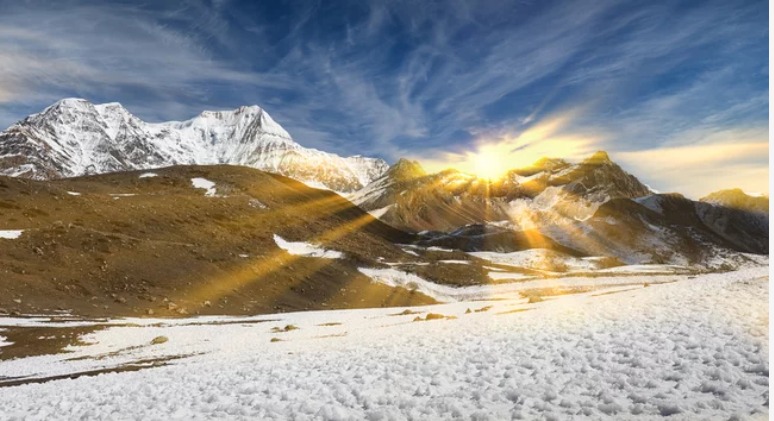
Jan 29, 2024
Annapurna Circuit Trek in February
- Can you do Annapurna Circuit in February?
- Is February a good time to trek in Nepal?
- What time of year is best for Annapurna Circuit trek?
- What is the weather like in Annapurna in February?
- Highlights of Annapurna Circuit trek in January and February
- Facts of Annapurna Circuit Trek
- Weather conditions of Annapurna Circuit Trek In January and February
- Fitness Level Required For Annapurna Circuit Trek in January and February
- Annapurna Circuit Trek Difficulty in January and February
- Pros of Trekking in January and February
- Cons of Trekking in January and February
- Accommodation During the Trek
- Foods During the Trail
- Training and Preparation for Annapurna Circuit Trek During The February
- Conclusion
- Annapurna Circuit Packages
Trekking the Annapurna Circuit in February offers a unique experience amidst Nepal's winter landscape. While February is considered one of the coldest months in the Himalayas, it provides adventurous trekkers with stunning vistas, quieter trails, and a chance to witness the region's natural beauty in its snow-covered splendor.
Weather conditions in February along the Annapurna Circuit are typically cold, with daytime temperatures ranging from 5 to 10 degrees Celsius (41 to 50 degrees Fahrenheit) at lower elevations. However, temperatures drop significantly at higher altitudes, often dipping well below freezing, especially during the night. Trekkers must be prepared with adequate cold-weather gear, including insulated jackets, thermal layers, gloves, hats, and a warm sleeping bag rated for sub-zero temperatures.
Snowfall is common in February, adding to the challenge and beauty of the trek. The landscape transforms into a winter wonderland, with snow-covered peaks, frozen waterfalls, and crystal-clear skies offering breathtaking photographic opportunities.

15 DAYS ANNAPURNA CIRCUIT TREK
A WILD ADVENTURE AMONG SOARING PEAKS - THE DEEPEST VALLEY ON EARTH & EXPOSURE TO UNIQUE CULTURES.THIS TREK HAS IT ALL!The 15 Days Annapurna Circuit Trek is time well spent and will leave you with...
Accommodations along the Annapurna Circuit in February include teahouses that provide basic but essential amenities such as warm beds, blankets, and meals. While some teahouses may close or have limited services at higher altitudes, many along the main routes remain open to accommodate trekkers.
Trekking in February also offers solitude on the trails, as it is considered an off-peak season. Trekkers can enjoy quieter paths and a more intimate experience with the local culture and environment.
Overall, while trekking the Annapurna Circuit in February presents challenges such as cold temperatures, potential snowfall, and limited services at higher elevations, it rewards adventurers with unparalleled natural beauty and a sense of tranquility amidst Nepal's majestic Himalayas. With proper preparation and a spirit of adventure, February offers a memorable journey through one of the world's most iconic trekking routes.

14 DAYS ANNAPURNA CIRCUIT TREK
RECOMMENDED WORLDWIDE! VISIT THE HIGHEST PASS & DEEPEST GORGE. An opportunity of a lifetime and adventure seeker’s paradise!The Annapurna Circuit Trek in 14 days with a drive to Chame and Muk...
Can you do Annapurna Circuit in February?
Yes, you can trek the Annapurna Circuit in February, but it requires preparation for winter conditions. February is considered one of the coldest months in the Himalayas, with temperatures dropping significantly, especially at higher elevations. Trekkers should be well-equipped with warm clothing, including insulated jackets, thermal layers, gloves, hats, and a sleeping bag rated for sub-zero temperatures. Trails may be snowy and icy, requiring careful navigation and possibly the use of trekking poles or crampons for stability. While some teahouses along the route may have limited services or close due to weather conditions, many remain open to accommodate trekkers. It's essential to plan your itinerary carefully, considering weather forecasts and trail conditions.
Is February a good time to trek in Nepal?
February can be a good time to trek in Nepal for those seeking a quieter experience with fewer tourists on the trails. The weather is cold and crisp, offering clear skies and stunning views of snow-covered peaks. While temperatures are cold, especially at higher altitudes, the reduced crowds allow for a more peaceful trekking experience. Trekkers should be prepared for winter conditions and ensure they have appropriate cold-weather gear and accommodation arrangements. Overall, February provides a unique opportunity to enjoy Nepal's Himalayan landscapes without the peak-season crowds.
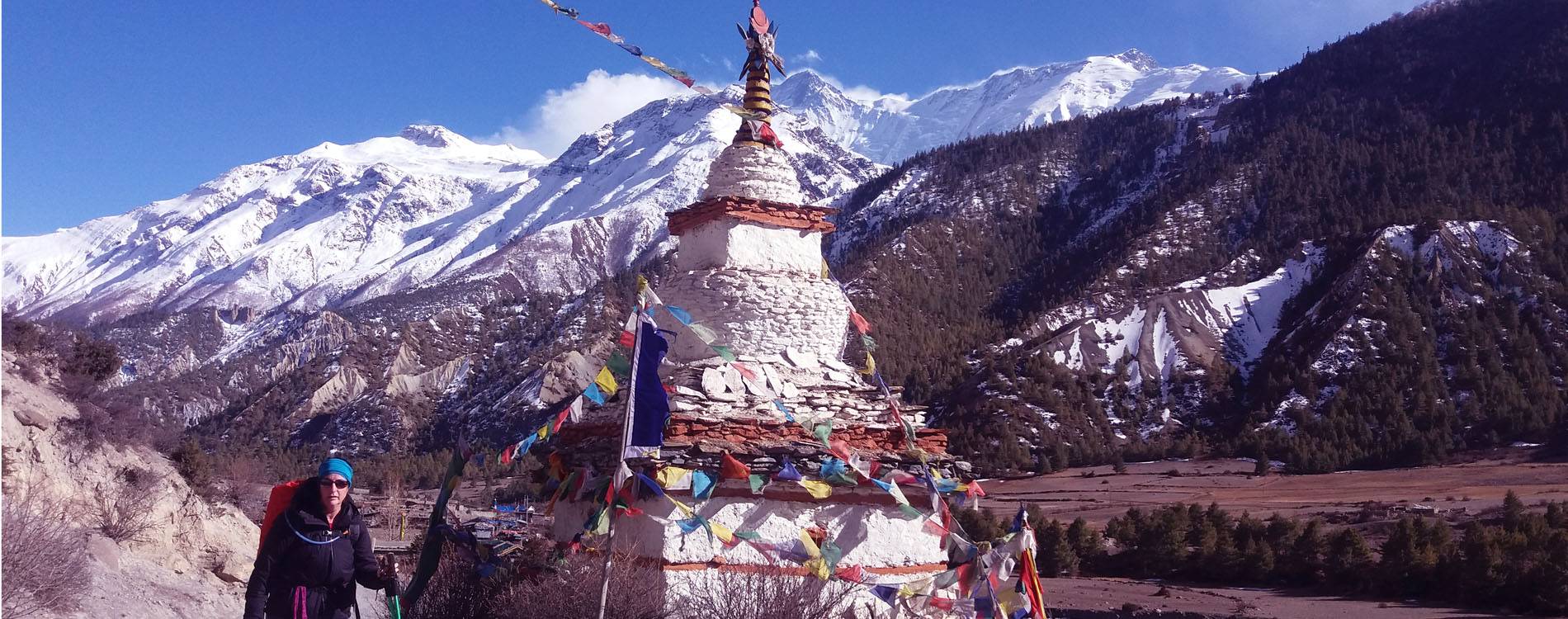
12 DAYS ANNAPURNA CIRCUIT TREK
This classic 12 Days Annapurna Circuit Trek is one of the most popular treks in Nepal. Every year thousands embark on this adventure and return with memories to last a lifetime! On this trek you...
What time of year is best for Annapurna Circuit trek?
The best times for the Annapurna Circuit trek are generally autumn (September to November) and spring (March to May). During these seasons, the weather is mild, with stable temperatures, clear skies, and less chance of precipitation. The trails are also at their busiest, offering opportunities to meet other trekkers and experience local culture at its peak. Winter (December to February) can also be a good time for experienced trekkers who prefer quieter trails and are prepared for cold weather and possible snowfall. Summer (June to August) is monsoon season, with heavy rains making trekking difficult and trails muddy and slippery.
What is the weather like in Annapurna in February?
Weather in Annapurna in February is cold and snowy, especially at higher elevations. Daytime temperatures at lower altitudes can range from 5 to 10 degrees Celsius (41 to 50 degrees Fahrenheit), but temperatures drop below freezing at night and at higher altitudes. Snowfall is common, covering the landscape in a pristine white blanket and adding to the scenic beauty of the trek. Trekkers should be prepared for cold conditions and ensure they have adequate cold-weather gear to stay warm and comfortable. Despite the cold, February offers clear skies and stunning views of snow-capped peaks, creating a picturesque backdrop for trekkers exploring the Annapurna region.

10 DAYS ANNAPURNA CIRCUIT TREK
Short of time does not mean you should miss out on this spectacular adventure!The 10 days Annapurna Circuit Trek takes you by road directly to the higher altitude villages of Besisahar, Chame & Ma...
Highlights of Annapurna Circuit trek in January and February
Trekking the Annapurna Circuit in January and February offers unique highlights amidst Nepal's winter wonderland. Here are some key highlights:
- Snow-Covered Landscapes: Experience breathtaking views of snow-capped peaks, frozen waterfalls, and pristine winter landscapes along the trekking route.
- Quiet Trails: Enjoy a more serene trekking experience with fewer tourists on the trail during the off-peak winter season.
- Cultural Encounters: Interact with local communities and experience their hospitality amidst the winter season, gaining insights into traditional Nepali mountain life.
- Clear Skies: Despite cold temperatures, January and February often offer clear skies, providing stunning photographic opportunities and panoramic views of the Himalayas.
- Challenging Adventure: Embrace the challenge of trekking in colder temperatures and potential snowfall, offering a rewarding sense of accomplishment.
Facts of Annapurna Circuit Trek
The Annapurna Circuit trek is renowned for its:
- Length and Duration: Spanning approximately 160-230 kilometers (100-145 miles), the trek typically takes around 15-18 days to complete, depending on the chosen route and pace.
- Diverse Landscapes: From lush subtropical forests and terraced fields in the lower regions to arid desert-like landscapes and high-altitude passes above 5,000 meters (16,400 feet).
- Cultural Diversity: Passing through diverse ethnic communities, including Gurung, Manangi, and Thakali, each with its own traditions, languages, and architecture.
- Thorong La Pass: The highest point of the trek at 5,416 meters (17,769 feet), offering panoramic views of the Annapurna and Dhaulagiri mountain ranges.
- Teahouse Accommodations: Providing basic but comfortable lodging and meals along the route, allowing trekkers to experience local hospitality.
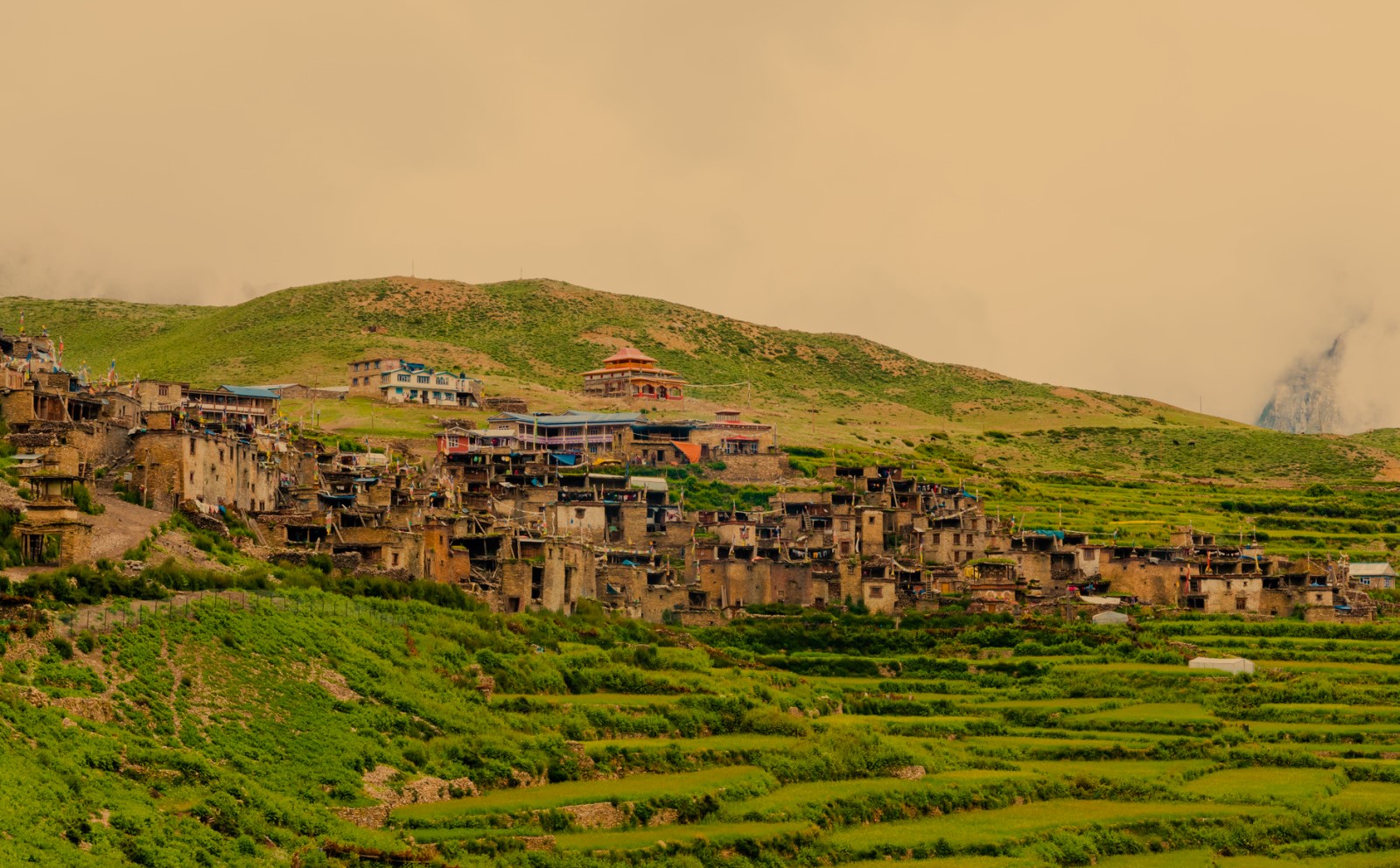
Nar Phu Valley Trek 8 Days
Embark on an unforgettable journey through the mystical Nar Phu Valley Trek, a hidden gem in the Annapurna region of Nepal. This 8-day adventure begins in the bustling city of Kathmandu, where you wil...
Weather conditions of Annapurna Circuit Trek In January and February
Weather conditions along the Annapurna Circuit in January and February are characterized by cold temperatures and occasional snowfall:
- Temperature: Daytime temperatures at lower altitudes range from 5 to 10 degrees Celsius (41 to 50 degrees Fahrenheit), but temperatures drop significantly at higher elevations, often well below freezing.
- Snowfall: Snowfall is common, especially in February, transforming the landscape into a winter wonderland with snow-covered trails and peaks.
- Clear Skies: Despite cold temperatures, trekkers often enjoy clear skies in January and February, offering stunning views of the surrounding mountains and landscapes.
- Trail Conditions: Trails may be snowy and icy, requiring careful navigation and possibly the use of trekking poles or crampons for stability.
- Teahouse Operations: While some teahouses may close at higher altitudes due to weather conditions, many along the main routes remain open to accommodate trekkers with basic amenities.
Overall, while January and February present colder and more challenging trekking conditions along the Annapurna Circuit, they offer a unique opportunity to experience Nepal's Himalayan beauty in its winter glory. Proper preparation and cold-weather gear are essential for a safe and enjoyable trekking adventure during these months.

Nar Phu Valley With Tilicho Lake Trek 15 Days
Embark on a transformative journey through the mystical landscapes of the Nar Phu Valley with Tilicho Lake Trek, a 15-day adventure that promises unparalleled natural beauty, cultural immersion, and t...
Fitness Level Required For Annapurna Circuit Trek in January and February
Trekking the Annapurna Circuit in January and February demands a good level of fitness due to the challenging winter conditions and high altitudes. Trekkers should have:
- Cardiovascular Endurance: Ability to walk for several hours a day, often on steep terrain and at varying altitudes.
- Strength and Stamina: Muscular strength, especially in the legs, to manage ascents and descents, and stamina to endure long days of trekking.
- Cold-Weather Tolerance: Adaptability to cold temperatures and potentially snowy or icy trail conditions, which require physical resilience and mental preparedness.
A regular fitness regimen prior to the trek, including hiking, jogging, and strength training, can significantly enhance trekking performance and overall enjoyment.
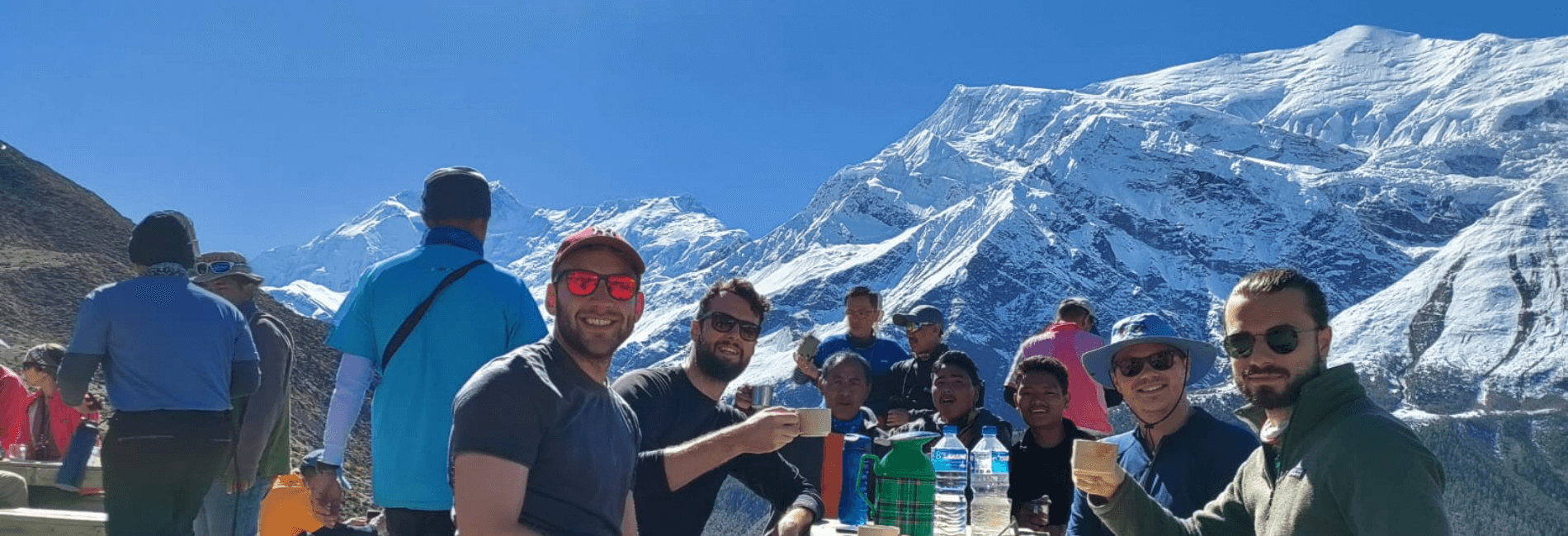
ANNAPURNA CIRCUIT TREK 7 DAYS
The 7 days Annapurna Circuit Trek is, for a good reason, one of the most popular treks in Nepal’s Annapurna Conservation Area where you will witness enormous snow-covered mountains, deep gorges &...
Annapurna Circuit Trek Difficulty in January and February
Trekking the Annapurna Circuit in January and February poses several challenges due to winter conditions:
- Weather: Cold temperatures, snowfall, and potentially icy trails increase the difficulty of trekking, requiring proper cold-weather gear and careful navigation.
- Altitude: The trek reaches altitudes over 5,000 meters (16,400 feet) at Thorong La Pass, necessitating gradual acclimatization to avoid altitude sickness.
- Trail Conditions: Snow-covered paths and slippery trails may require the use of trekking poles or crampons for stability.
Despite these challenges, trekking in winter months offers quieter trails, stunning snowy landscapes, and a unique adventure for experienced trekkers prepared for the conditions.
Pros of Trekking in January and February
Trekking the Annapurna Circuit in January and February offers several advantages:
- Quieter Trails: Fewer tourists provide a more serene trekking experience with less crowded teahouses and trails.
- Winter Scenery: Snow-covered peaks, frozen waterfalls, and clear skies create picturesque landscapes for photography and exploration.
- Cultural Interaction: Enhanced opportunities to engage with local communities and experience traditional mountain life amidst the quieter winter season.
- Challenging Adventure: For those seeking a more challenging trekking experience, winter conditions add an element of adventure and personal accomplishment.

ANNAPURNA CIRCUIT TREK 8 DAYS
The Annapurna Circuit Trek is, for a good reason, one of the most popular treks in Nepal’s Annapurna Conservation Area where you will witness enormous snow-covered mountains, deep gorges & high al...
Cons of Trekking in January and February
However, trekking in January and February has its drawbacks:
- Cold Weather: Sub-zero temperatures and potential snowfall require adequate cold-weather gear and careful preparation.
- Limited Services: Some teahouses may close or have reduced services at higher altitudes, impacting accommodation and food options.
- Trail Conditions: Snow and ice can make trails slippery and challenging to navigate, requiring additional caution and possibly equipment like crampons or trekking poles.
- Altitude Risks: Higher altitudes increase the risk of altitude sickness, necessitating proper acclimatization and awareness of symptoms.
Accommodation During the Trek
Accommodation along the Annapurna Circuit in January and February typically consists of teahouses offering basic but essential amenities:
- Teahouse Lodging: Options range from simple dormitories to private rooms with basic bedding and shared facilities.
- Cold-Weather Comfort: Trekkers should be prepared for cold nights and basic heating facilities, often provided by wood-burning stoves.
- Availability: While some teahouses at higher altitudes may close, many along the main routes remain open to accommodate trekkers with warm beds and meals.

ANNAPURNA CIRCUIT TREK 10 DAYS
This fabulous Annapurna Circuit Trek has considered one of the greatest treks in Nepal’s Annapurna Conservation Area with its massive snow-covered ranges, deep gorges & high altitude passes.This t...
Foods During the Trail
Food options along the Annapurna Circuit in January and February include hearty meals served at teahouses:
- Local Cuisine: Dal bhat (rice and lentils), noodles, soups, and occasionally Western dishes are commonly available, cooked fresh to provide warmth and nutrition.
- Snacks and Supplies: Trekkers should carry snacks such as energy bars and dried fruits for additional sustenance, especially in remote or less populated areas.
- Water: Boiled water or bottled water is typically available for purchase to ensure safe hydration during the trek.
While dining options may be limited at higher altitudes, teahouses strive to provide nourishing meals that cater to the needs of trekkers enduring cold weather and physical exertion.
Training and Preparation for Annapurna Circuit Trek During The February
Preparing for the Annapurna Circuit trek in January and February requires physical conditioning and logistical planning:
- Cardiovascular Fitness: Build endurance through activities like hiking, jogging, cycling, and stair climbing to prepare for long days of trekking.
- Strength Training: Strengthen leg muscles with exercises like squats, lunges, and calf raises to manage steep ascents and descents.
- Cold Weather Adaptation: Train in colder conditions to acclimatize your body to low temperatures. Practice layering clothing and using cold-weather gear.
- Altitude Acclimatization: Plan your trekking itinerary to include gradual altitude gain, rest days, and hydration to minimize the risk of altitude sickness.
- Mental Preparation: Prepare mentally for the physical challenges and potential weather extremes. Stay positive, flexible, and resilient during the trek.
By focusing on physical fitness, cold-weather preparation, and obtaining necessary permits, trekkers can maximize their enjoyment and safety while trekking the Annapurna Circuit in January and February.

ANNAPURNA CIRCUIT WITH TILICHO LAKE TREK 15 DAYS
This 15-day trek takes you through the Annapurna Conservation Area and to the highest alpine pass in the world – Thorong La Pass (5,416m/17,769ft) and to Tilicho Lake. You will also trek through the d...
Conclusion
Trekking the Annapurna Circuit in January and February offers a challenging yet rewarding adventure amidst Nepal's winter landscapes. With proper equipment, necessary permits, and thorough training, trekkers can navigate cold temperatures and potential snowfall while enjoying the serene beauty of the Himalayas. Preparation is key to ensuring a safe and memorable trekking experience, filled with breathtaking views, cultural encounters, and personal accomplishment in one of the world's most iconic trekking destinations.
Annapurna Circuit Packages
10 Days Annapurna Circuit Trek
12 Days Annapurna Circuit Trek
14 Days Annapurna Circuit Trek
15 Days Annapurna Circuit Trek
Annapurna Circuit With Tilicho Lake Trek 9 Days
Annapurna Circuit With Tilicho Lake Trek 15 Days
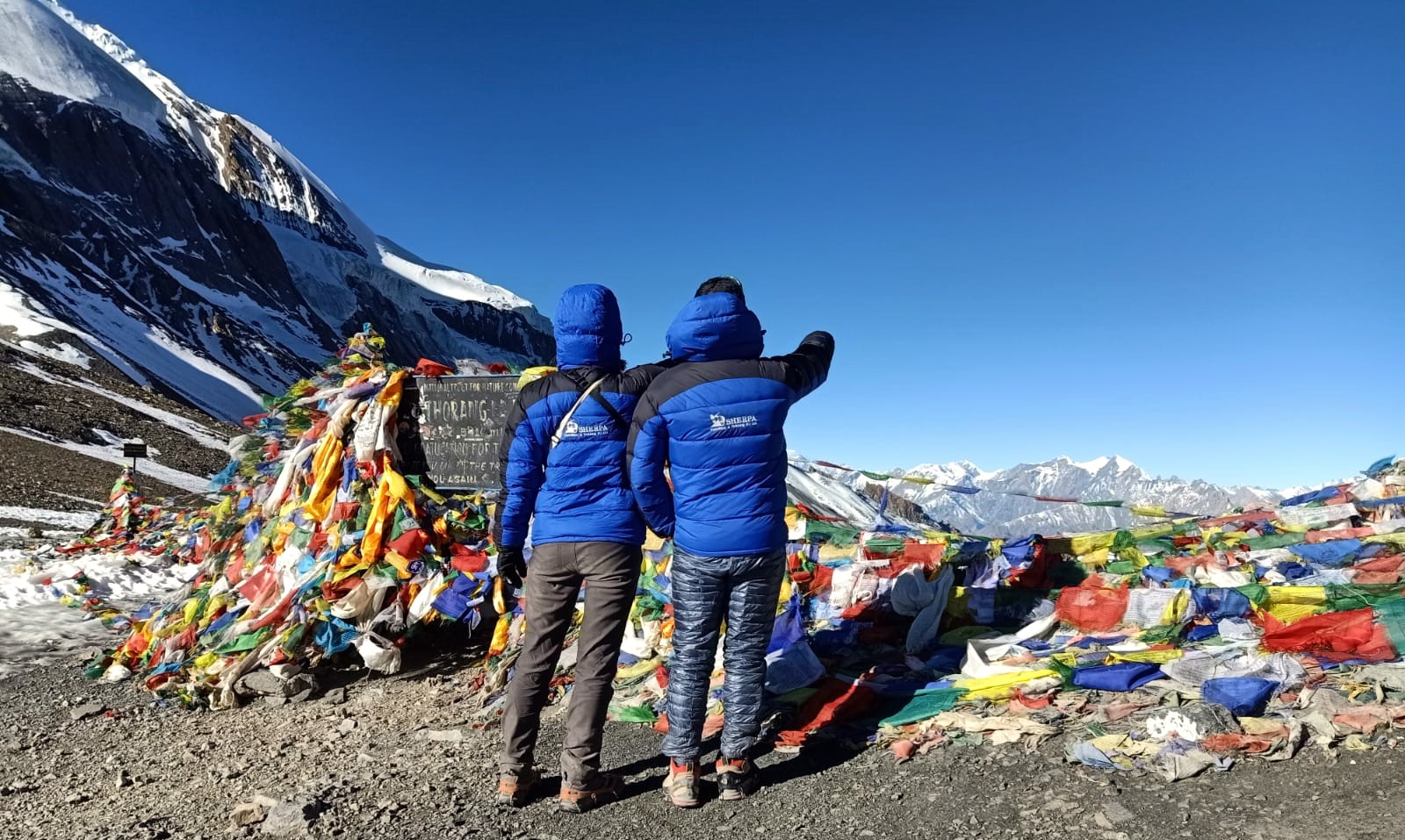
ANNAPURNA CIRCUIT WITH TILICHO LAKE TREK 9 DAYS
Short 9 Days Annapurna Circuit Trek with Tilicho Lake is one of the most impressive and challenging hikes in Nepal. It’s an incredibly popular trekking destination in Nepal and around the world given...
Any Questions? Let Us Know.
Recent Posts
17th June, 2025


















